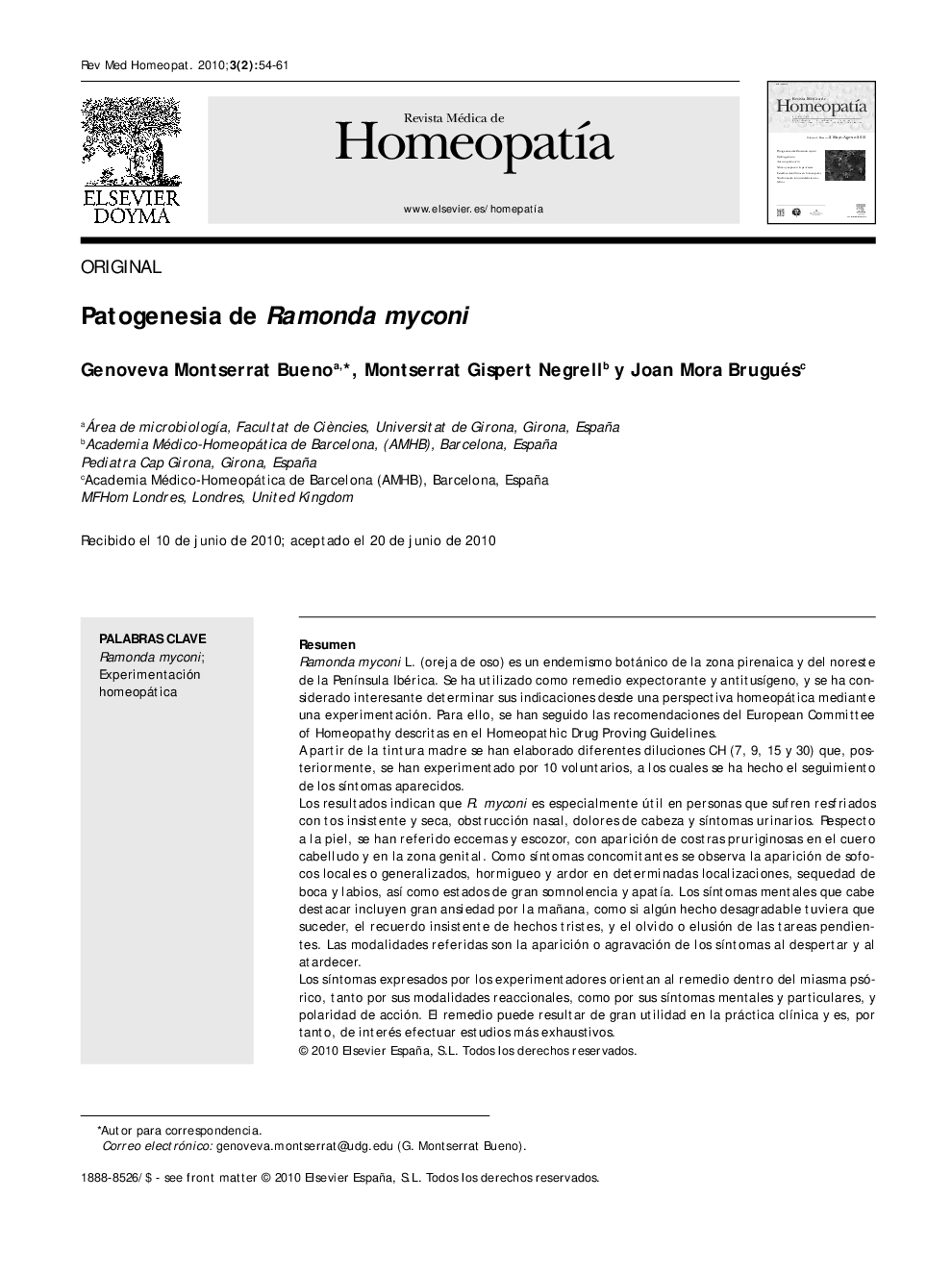| Article ID | Journal | Published Year | Pages | File Type |
|---|---|---|---|---|
| 3103033 | Revista Médica de Homeopatía | 2010 | 8 Pages |
ResumenRamonda myconi L. (oreja de oso) es un endemismo botánico de la zona pirenaica y del noreste de la Península Ibérica. Se ha utilizado como remedio expectorante y antitusígeno, y se ha considerado interesante determinar sus indicaciones desde una perspectiva homeopática mediante una experimentación. Para ello, se han seguido las recomendaciones del European Committee of Homeopathy descritas en el Homeopathic Drug Proving Guidelines.A partir de la tintura madre se han elaborado diferentes diluciones CH (7, 9, 15 y 30) que, posteriormente, se han experimentado por 10 voluntarios, a los cuales se ha hecho el seguimiento de los síntomas aparecidos.Los resultados indican que R. myconi es especialmente útil en personas que sufren resfriados con tos insistente y seca, obstrucción nasal, dolores de cabeza y síntomas urinarios. Respecto a la piel, se han referido eccemas y escozor, con aparición de costras pruriginosas en el cuero cabelludo y en la zona genital. Como síntomas concomitantes se observa la aparición de sofocos locales o generalizados, hormigueo y ardor en determinadas localizaciones, sequedad de boca y labios, así como estados de gran somnolencia y apatía. Los síntomas mentales que cabe destacar incluyen gran ansiedad por la mañana, como si algún hecho desagradable tuviera que suceder, el recuerdo insistente de hechos tristes, y el olvido o elusión de las tareas pendientes. Las modalidades referidas son la aparición o agravación de los síntomas al despertar y al atardecer.Los síntomas expresados por los experimentadores orientan al remedio dentro del miasma psórico, tanto por sus modalidades reaccionales, como por sus síntomas mentales y particulares, y polaridad de acción. El remedio puede resultar de gran utilidad en la práctica clínica y es, por tanto, de interés efectuar estudios más exhaustivos.
Ramonda myconi is endemic in the Pyrenees botanical and north-eastern Iberian Peninsula. It has been used as an expectorant and cough remedy, and it is worthwhile considering its indications from a homeopathic point of view, through a proving. To do this, we have followed the criteria of the ECH (European Committee of Homeopathy) described in the Homeopathic Drug Proving Guidelines.From the Mother Tincture, different dilutions CH (7, 9, 15 and 30) have been developed and experienced by ten volunteers, who have monitored the appearance of symptoms.The results indicate that R. myconi is especially useful in people who have colds and persistent dry cough, nasal obstruction, headache and urinary symptoms. As regards the skin, the proving has shown eczema and itching and the appearance of itchy scabs on the scalp and genital area. As concomitant symptoms, local or generalized hot flushes, tingling and burning in certain locations, dry mouth and lips without thirst have been described, as well as states of profound drowsiness and apathy. The mental symptoms include anxiety on waking up in the morning, as if something unpleasant is going to happen, dwelling on sad facts of the past, and forgetfulness or avoidance of the remaining tasks. The main reactional modalities are the onset or worsening of symptoms in the morning on waking and in the evening.The symptoms expressed by the volunteers place the remedy within the psoric miasma: reactional modalities, mental and particular symptoms and the polarity of action are within the range of psora. This remedy may be useful in clinical practice and therefore further research would be of interest.
